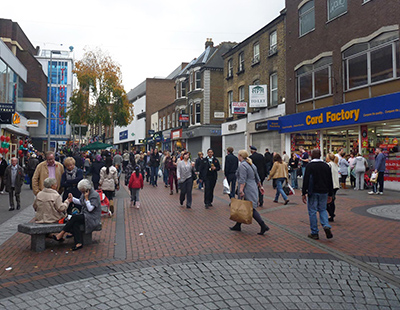It’s been confirmed that construction has begun on the transformational development of 170 new homes at the former Swinden Technology Centre in Rotherham.
Keepmoat Homes is delivering the regeneration scheme in partnership with Rotherham Metropolitan Borough Council, with the plans including the conversion of Lodge House, Swinden House, Sitwell House, and the former Stable Building into high-quality apartments.
Two four-bedroom houses will also be delivered onto the site, with a proportion of the homes set to be available for affordable housing with Auxesia Homes. Keepmoat Homes, one of the UK’s leading housebuilders and developers, has also confirmed the development will preserve any mature trees at the site.
As part of its commitment to the local community, Keepmoat Homes has pledged to support local people and help generate opportunities in training and employment through the use of sub-contractors, work placements and educational visits to the site, set to be delivered throughout the lifetime of the project.
Daniel Crew, regional managing director at Keepmoat Homes, commented: “We are very excited to have started work on our Moorgate Boulevard development in Rotherham, in partnership with Rotherham Metropolitan Borough Council and Auxesia Homes. We have a strong track record of delivering new houses across the country, particularly on brownfield land such as this and strive to ensure the heritage at the site is preserved.”
He added: “This development means more to us than just delivering quality homes to the area. Being our first site in Rotherham for over a decade, we’re driven to make a big impact to the local community and deliver real value to real people, whether that’s through training and career opportunities or supporting local community groups. We are confident that the development will benefit not only the area, but the lives of those who choose to live there.”
Keepmoat Homes completed the purchase of the site from Tata Steel in October 2021 for an undisclosed sum, with Harris Lamb acting as agents on its behalf.
Development work is anticipated to take four years to complete, with the first homes becoming available to purchase in late summer 2022.
Additionally, Keepmoat Homes has secured a site for 470 new homes in Bridlington, on land previously used for the Strawberry Fields car boot sale.
The land has been purchased from private landowners for an undisclosed sum and will be transformed into a new housing development.
The site has been earmarked for transformation for several years, with planning approval already granted by the East Riding Council’s planning committee in August 2021.
Made up of a mix of one, two, three and four-bedroom detached semi-detached homes, along with two-bedroom bungalows, the 470-home scheme is also set to feature ‘substantial attractive green open spaces’ for recreational use, as well as a fully equipped play area and two new sports pitches. The developers also say the woodland area nearby will be retained along with the ecology green corridor along Bessingby Beck.
The development, which will be named Salkeld Meadows, is aiming to generate opportunities in training and employment through the use of sub-contractors, work placements and educational visits to the site.
“We are really excited to transform the site, which is in a prominent location by the sea, into a new neighbourhood,” Crew added.
“I am very familiar with the area as I spent many childhood summers with my grandparents just across the road from the site, and I know it will be a desirable place to live.”
He added: “Our vision is to create a place where people want to live and enjoy, and we’re driven to ensure the development is a major benefit to the local community. The layout of the development has been consciously designed with the health and wellbeing of the residents in mind, with the homes being positioned alongside public spaces and designed to be inclusive and meet the changing needs of people of different ages and abilities.”
Work at the development is expected to begin in January 2022 and will take 10 years to complete.
New York and Westminster
The largest office to residential conversion in the history of New York is currently underway, transforming One Wall Street, previously the headquarters of the Irving Trust Company (Bank of New York), into 566 condominiums, 100,000 sq ft of amenity space at ‘The One Club’ and 174,000 sq ft of retail space of which Whole Foods and Life Time have already been announced.
The 1,200,000 sq ft development was acquired by Harry Macklowe, the mastermind behind 432 Park Avenue, the GM building and the Apple Cube.
With sales and first occupancies set for later this year (and completion in 2022), the building will also include a state-of-the-art athletic club, full-floor entertainment space, dog grooming and spa services - all with unobstructed views of New York Harbour and the Statue of Liberty.
Residents at One Wall Street will have access to almost every single train line running throughout NYC, with train stops on most streets and a major ferry hub just a five-minute walk down the road. The residents will also be able to enjoy a generous garden terrace, complete with an outdoor kitchen and spacious lounge areas, which overlook the Manhattan skyline.
In London, meanwhile, the restoration of Westminster Fire Station is currently taking place, repurposing the building into a collection of no-two-the-same 18 boutique apartments and a destination restaurant, developed by Alchemi Group.
The reimagining of the existing Grade II-listed fire station is being developed alongside The Station House, a contemporary counterpart designed by Openstudio Architects.
Additionally, the old engine room will house a destination restaurant, Mathura by Michelin-starred chef Atul Kochhar, where the fireman's pole, watch room - which will be used as a private dining room in the restaurant - and the original carriage doors that will form the main entrance to the building and restaurant, have been restored and kept as original features.
The ‘glazed brick-covered walls and exposed steel beams’ pay homage to the building's former use, while the four-metre-high ceilings add to the sense of grandeur.
Westminster Fire Station is described as a quintessentially English Edwardian interpretation of eighteenth and nineteenth-century Baroque architecture, in much the same way as some of its notable London neighbours, such as Buckingham Palace and St Paul’s Cathedral.
For this restoration, the development team says it has gone to great lengths to sensitively reimagine the original heritage building and match the design and architecture to its former appearance.
However, the new Station House has also been added behind the Fire Station to extend the space - sandwiched together with ‘a green courtyard oasis’.
Residents will be only a stone’s throw away from one of the largest transport hubs in the city and an ever-growing list of bars and restaurants are within a few minutes’ walk of the development.
Former office block in Hounslow gets a makeover
Prime developer Harbright has unveiled its first development outside the centre of the capital at Whitelocke House, in West London.
Situated in the heart of well-connected Hounslow town centre, the ‘boutique development of stylish apartments’ are aimed at first-time buyers, those seeking a London base and property investors looking to turn a profit.
The building in question is a former office block that had stood empty for a number of years. In 2019, Harbright purchased the building and work started last year to transform it into 34 studio, one-bedroom and one-bedroom plus study apartments.
“Our track record in prime developments is reflected in the approach we have taken at Whitelocke House, creating super-smart apartments with excellent specification for discerning buyers, which offer real value to people looking to buy a home in London,” Henry Hardy, director of Harbright, said.
“The structure and dimensions of the former office building have made a great residential conversion. In many ways, it is better than a new build block. It has impressive floor to ceiling heights, extensive windows and glazing and wide communal corridors.”
He added: “The way the building has been constructed for office use means that the acoustic separation between floors is greater than you would find in a new build residential block, providing better soundproofing. The result is a collection of high quality, well-proportioned homes. Anticipated gross rental yields are in excess of 5% for investors looking to buy and make the homes available for lettings.”
From banks to churches…
Meanwhile, high-end agency Fine & Country has a number of commercial to residential conversions currently on its books, including the redevelopment of a Grade 2-listed former bank in Cumbria and a former station master’s house in Scotland that dates from the 19th century and has now been restored to its former glory as a three-bedroom detached house with many original features present.
There’s also a four-bedroom converted church for sale in Blackburn Road, Accrington, on the market for £500,000 and sympathetically restored, and a four-bedroom detached house in Kenilworth, Warwickshire, converted from a former water tower.
Described as being an incredible opportunity to acquire a piece of Kenilworth’s history, the Water Tower is an iconic feature of the town and can be seen from many miles away. Originally thought to have been constructed as a windmill in the mid-18th century, then converted to a water tower in 1885, ‘it now sits very proudly as a striking home with modern living’.
Lastly, there’s The Bath House in St Leonards-on-Sea, close to Hastings, which is one of the town’s most historic, cleverly converted homes. According to Fine & Country, its past tells stories of a school swimming bath, a church and a glass factory.
Completely dilapidated on purchase, the property has been renovated into a family home with bowling alley and home cinema.
Will the boom continue?
Will Kinnear, director of HEWN, a venture which advises property owners and operators in the flexible workspace sector, says the high street needs to be reset by understanding how towns and cities were originally formed, with retail blended with other uses – such as leisure, workspaces and residential.
“The challenge now is for councils and property owners to create a cohesive plan to make sure these spaces work for people – spaces for people to work, eat, shop, and utilise health and leisure facilities – this requires all stakeholders to think about how people use spaces.
He added: “We know that for sustained amounts of time, office employees are more productive with natural light. It’s an exciting opportunity to reimagine our towns and cities – and fundamentally rebuild our communities by utilising the infrastructure that is already in place. Flexible workspace should be an integral part of this by providing relevant, in demand space that people want to be located in.”
Nina Harrison, London Specialist at Haringtons, also commented: “High Streets have been in trouble with the explosion of internet shopping, but what we are seeing is the reinvention of the high street as we know it, with more concentrated shops and eateries that spill onto the pavements or boulevards with pedestrianised roads."
She added: "Consequently, we will see more commercial to residential conversions; but these won’t be the preserve of low-cost housing but places people want to be as there are amenities on the high street once again. And with the move to electric vehicles, these locations will be less polluted and more attractive spaces to be and live. I think what we will see is empty-nesters move out of their family homes back to the high street; freeing up family homes.”






.png)



.jpg)





Join the conversation
Be the first to comment (please use the comment box below)
Please login to comment